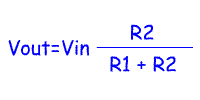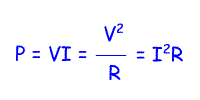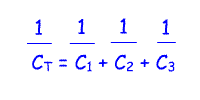Formula
|
What the formula is used for
|
Link to lessons in which this formula is used
|

|
For calculating
the total resistance of resistors connected in series.(Here for 3
resistors, but can be extended for any number of resisters)
|
Lesson 14
|
 |
For calculating
the total resistance of resistors connected in parallel.(Here for 3
resistors, but can be extended for any number of
resisters) |
Lesson 14
|
 |
For calculating the output voltage for a potential divider made up of two parallel resistors.
|
Lesson 16
|
 |
For calculating the voltage in a circuit where current(I) and resistant are known. By rearranging the formula I=V/R and R=V/I
|
Lesson 15
Lesson 71 |
 |
For calculating the power in a circuit. P=VI when voltage and current are known. P=V2 /R when voltage and resistance are known. I2/R when current and resistance are known.
|
Lesson 15
|
 |
To calculate the rms (Root Mean Square) voltage of a sine wave from the peak voltage of the sine wave.
|
Lesson 20
|
 |
| For
calculating the total capacitance of capacitors connected in
series.(Here for 3 capacitors, but can be extended for any number of
capacitors) |
|
Lesson 18
|
 |
For calculating
the total capacitance of capacitors connected in parallel.(Here for 3
capacitors, but can be extended for any number of
capacitors) |
Lesson 18
|
 where k= εoεr = dialectric constant of the material between the plates (εr) x 8.854x10-12 (εo) where k= εoεr = dialectric constant of the material between the plates (εr) x 8.854x10-12 (εo) |
For
calculating the value of a capacitor from A (the area of the plates), k
(the dialectric constant of the dialectric sandwiched between the
plates) and d (the distance apart of the plates).
|
Lesson 17
|
 |
| For calculating the
total inductance of inductors connected in series.(Here for 3 inductors, but can be extended for any number of inductors) |
|
Lesson 19
|
 |
For calculating the
total inductance of inductors connected in parallel.(Here for 3 inductors, but can be extended for any number of inductors) |
Lesson 19
|
 |
For calculating the reactance of a coil in an AC circuit.
|
Lesson 22
|
 |
For
calculating the impedance of a series circuit consisting of a resistor
and either a capacitor or inductor of known reactance.
|
Lesson 21
|
 |
For
calculating AC voltage across the components of a circuit
comprising a series resistor and capacitor OR a series resistor and
inductor.
|
Lesson 21
|
 |
For calculating the reactance of a capacitor in an AC circuit.
|
Lesson 22
|
 |
For calculating the resonant frequency of an LC circuit.
|
Lesson 22
|
 |
For calculating the time for the completion of one cycle of an AC signal when the frequency is known.
|
Lesson 20
Lesson 72
|
 |
To calculate the
time constant of a circuit comprising a capacitor in series with
a resistor. The time constant is the time to charge the capacitor to
63% of the supply voltage.
|
Lesson 18
|
 |
To calculate the Q or quality factor for a resonant circuit given the L or C and resistance in the circuit
|
Lesson 22
|
 |
To
calculate the Q or quality factor for a resonant circuit given the
centre frequency together with the upper and lower frequencies.
|
Lesson 22
|
 |
To calculate the dynamic resistance of a parallel tuned circuit
|
Lesson 23
|
 |
Another method of calculating Q knowing the capacitance and dynamic resistance in a parallel tuned circuit.
|
Lesson 22
|
 |
The
transformer formula showing how the number of volts on the primary of a
transformer are related to the voltage on the secondary
|
Lesson 24
|
 |
The transformer formula showing how the number of amps on the primary
of a transformer are related to the amps on the secondary
|
Lesson 24
|
 |
The transformer formula showing how the impedance of the primary
of a transformer is related to the impedance of the secondary
|
Lesson 24
|
 |
The collector current flowing through a transistor is equal to the beta of the transistor multiplied by the base current.
|
Lesson 29
|
 |
The channel spacing of a synthesiser is equal to the crystal frequency divided by the output number from the fixed divider
|
Lesson 35
|
 |
The
frequency out from a synthesiser is = to the frequency of the crystal
multiplied by N (the programmable divide by number) divided by the
fixed divide by number.
|
Lesson 35
|
 |
The velocity of light / radio waves in free space and air is given by the symbol c as 3 x 108 m/s
|
Lesson 48
|
 |
The velocity of a radio wave is equal to the frequency times the wavelength.
|
Lesson 49
|
 |
The gain or loss of power in dBs
|
Lesson 32
|
 |
The gain or loss of voltage in dBs
|
Lesson 32
|
 |
For calculating the Return Loss on an antenna feeder
|
Lesson 51
|
 |
Calculates the gain in dBs of a Yagi antenna.compared to a dipole
|
Lesson 49
|
 |
The method used to calculate SWR by measuring the max maximum and minimum voltage on open wire feeder.
|
Lesson 51
|
 |
The formula used to match two different impedances with a quarter wave length of coax.
|
Lesson 48
|
 |
Used
to estimate the bandwidth required for communication systems for a
carrier signal that is frequency modulated by a continuous or broad
spectrum of frequency rather than a single frequency.
|
Lesson 37
|
 |
Calculation of field strength over short distances.
E=the field strength (peak) in volts per metre
d= d is the distance
from the transmitting antenna in metres
erp=effective radiated power from the antenna
|
Lesson 60
|
 |
Used to calculate the erp from an antenna.
|
Lesson 49
|








 where k= εoεr = dialectric constant of the material between the plates (εr) x 8.854x10-12 (εo)
where k= εoεr = dialectric constant of the material between the plates (εr) x 8.854x10-12 (εo) 




























